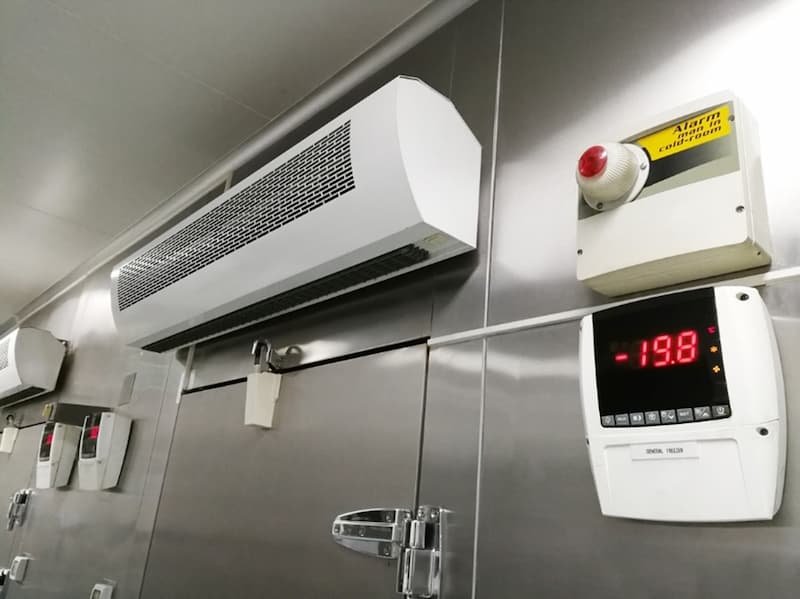Maintaining product integrity is vital in the supply chain and fulfilment sectors. However, cold chains have extra restrictions related to the environment where the product needs to be stored.
Whether it's commercial food goods or pharmaceuticals, without maintaining the right environment, products will quickly spoil, resulting in damage to your business. Fortunately, storage environment integrity is easily monitored with automated thermal imagers, creating a significantly improved condition-monitoring network for your products and overall business.
What Is Thermal Imaging?
Thermal imaging cameras are an excellent tool for monitoring the temperature of an environment. These imagers monitor specific temperature parameters by detecting the infrared radiation emitted by observed objects with a special sensor. This thermal data map is overlayed onto conventional video footage recorded simultaneously and creates an easy-to-interpret assessment of nearby temperatures.
These cameras come in many forms, from small mobile phone modules to hand-held imagers to automated thermal imaging cameras. The size of the camera is often an indication of the amount of detail your footage will have for later analysis.
The footage is observable on the camera, but many users will upload the data to a computer, where it will be analysed in more detail. Our cameras used in thermography inspections detect temperature differences as small as 0.1 °C, making them highly sensitive to changes in temperature.
Thermal Imaging for Cold Store Insulation Assessments
A is a highly adaptable piece of assessment equipment used in many commercial and industrial areas, and one factor unites all these applications: locating heat. This task is more obvious in other roles, such as thermal imaging cameras used in fire safety or machine maintenance; this becomes more subtle with cold store monitoring.
The room-sized cold rooms often employed in cold supply chains are monitored and assessed with a thermal imaging camera similar to standard infrared building inspections, but instead of searching for heat loss through insulation, they are used to find heat leaking inwards. The techniques used are similar and effective, as spotting leaking cold air is more difficult than spotting the bright colours associated with hot spots.
What Faults Do Thermal Imaging Cameras Reveal in Cold Stores?
The main issue that could be revealed is where the environment is compromised. A compromised cold store is an escalating problem that, at the least, will significantly increase your energy expenses as you have to increase your refrigeration to compensate for the dropping heat. The most extreme result is that your environmental temperature exceeds the required parameters, resulting in a loss of stock. Here are examples of common areas that need monitoring in a cold storage facility.
Faulty Insulation
The main way an environment is compromised is when the insulation surrounding the cold room is ineffective. This can either be from poor installation or from wear and tear from extensive use. Moisture will freeze and form hazardous ice formations on your walls and roof, damaging the surrounding materials and creating opportunities for cold air leaks. This moisture will come from either newly added stock or from the external space around the cold storage area if the insulation is not kept in the best condition.
Heat Bridges
Heat (or thermal) bridges are a potential source of temperature contamination for cold storage spaces of any size if they have been constructed poorly. For example, the joints between insulation panels may not be protected correctly, and a heat bridge may be created to connect with the rest of the building.
The negative outcome of a thermal heat bridge is that it manipulates the temperature flow of your structure, which will change depending on the temperature of the rest of your nearby storage spaces, such as increasing warmth during a summer heat wave. This erratic temperature change can be sourced and eliminated with the temperature data provided by a thermal imaging camera.
Electrical System Assessment
Whilst not exclusive to cold storage facilities, an electrical thermographic survey is beneficial for guaranteeing consistent and reliable operation. All thermographic surveys are a non-invasive method for assessing the condition of electrics. This means that a trained engineer will conduct a survey on vital areas such as electrical panels and systems whilst they are being used uninterrupted during your daily operations. Using our range of high-end cameras, it will be immediately apparent which elements of your electrics are running within intended parameters and which need maintenance, as they will display either a lack of heat from failure or excessive heat from overheating.
Automated Thermal Imaging for Cold Store Monitoring at Thermascan
At Thermasacan, we stock a broad range of options with our thermal imaging cameras for hire or sale. These hand-held and static units provide an immense amount of temperature data essential for guaranteeing the integrity of your cold store its contents.
Additionally, we have a team of level II certified field engineers, who are experts in conducting on-site inspections to identify and address thermal issues using our popular thermographic surveys. Whether you need a one-off survey or part of a regular HVAC or machine maintenance program, you should contact us, and our expert team will help you find those faulty areas of your cold store you didn’t know existed.





